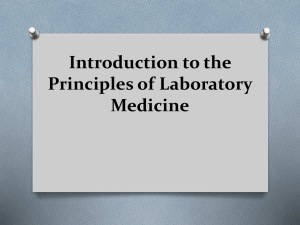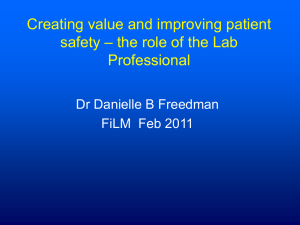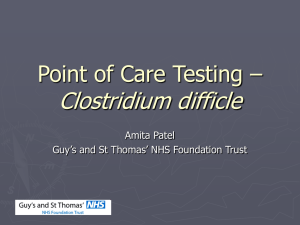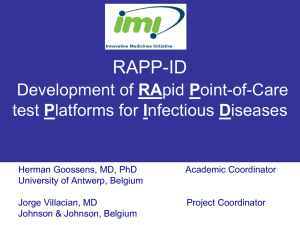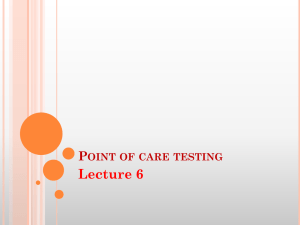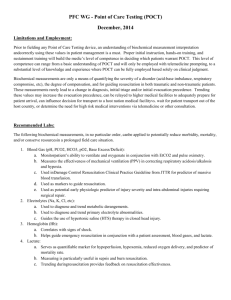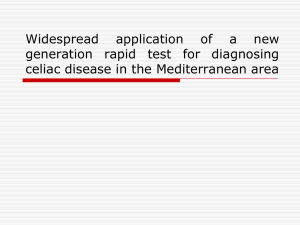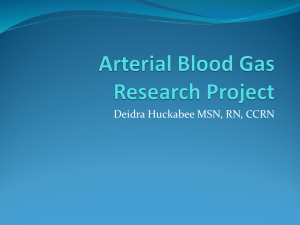Getting the Service Right
advertisement
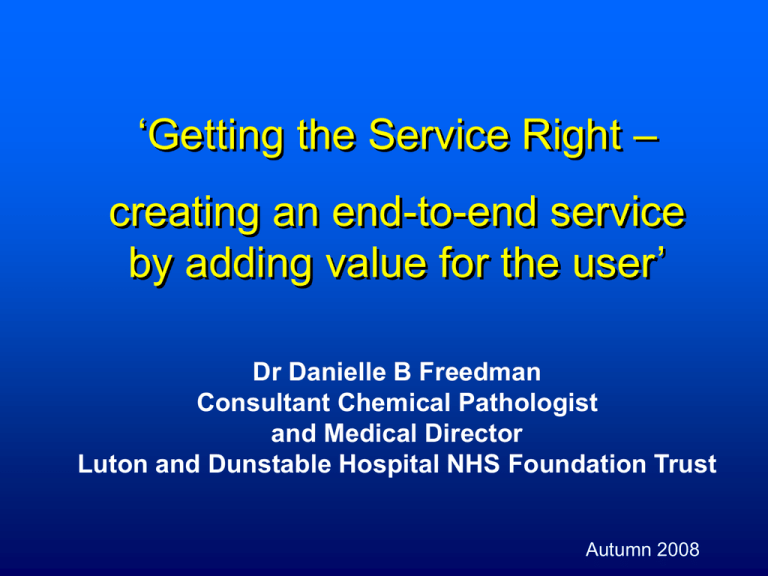
‘Getting the Service Right – creating an end-to-end service by adding value for the user’ Dr Danielle B Freedman Consultant Chemical Pathologist and Medical Director Luton and Dunstable Hospital NHS Foundation Trust Autumn 2008 What do users really want? Role of Laboratory interface • Value of interpretative service • Demand management • Patient safety Pathways Effective use of POCT New Directions in the NHS in UK • Our health, our care, our say (2006) - focus on prevention and health promotion more care outside of hospital and in home encouraging innovation and competition joined up approach New Directions in the NHS in UK • ‘Looking to the Future Out of Hospital Report’ (2007) ‘Treatment of all patients in ‘out of the hospital’ as the ‘norm’, treatment by acute services as the exception 1 Co location of 1° care in A & E 1° care replacing many existing A & E functions – 50% A & E attendances in alternative setting eg increased investment in community teams who can offer intensive support to patients with long term conditions Urgent care centres: 1°care led Minor injury/illness Diagnostics 2 Move 40% outpatient activity away from hospitals [Tariff 08 £189] 3 Non-complex surgery in 1° care 4 Poly Clinics Darzi – High quality for all • Create an NHS that helps people stay healthy • Vascular risk assessment • Long term conditions • Quality at the heart of the NHS • Clinically and cost effective innovations in medicines and medical technologies is adopted • Working in partnership with staff Quality in Health Care Laboratory Medicine and the Darzi agenda • Fair – equally available to all • Personalised – to individual needs • Effective – quality outcomes • Safe – confidence in the care received Darzi 2007 What do users want from Laboratory Medicine? • • • • • • Information to allow clinicians to make better decisions about patients Patient safety Clinical governance, accountability, accreditation … Investigations need to be cheap, quick and correct Right investigation on the right patient at the right time Report needs to get to the right clinician at the right time using the right medium Role of Laboratory Interface Clinical Vignette 48 year old male GP routine bloods Grossly lipaemic – triglyceride = 130 mmol/l (<1.9) DBF D/W GP – known alcoholic ? Risk of pancreatitis (from etoh and trigs) Commence ciprofibrate 100 mg od Cease etoh Suggest referral ASAP to hepatologist Obviated need for acute admission Clinical Vignette 56 year old Chinese male (poor historian) Previous A&E attendance with 1/52 headache – given some medicine Since then generally unwell – sweating, ? Weight loss GP requested TFT – fT4 = 6 pmol/l, TSH = 1.23 mU/l TSH inappropriate for fT4 – lab add other Ix Sodium = 128 mmol/l Other U&E NAD Cortisol (08:30am) = 108 nmol/l Testosterone = 2.9 nmol/L Prolactin 167 mU/l LH = 1.9 U/l, FSH = 2.8U/l Hydrocortisone cover advised, followed by replacement of other axes – Urgent Chemical Pathology OPD arranged with GP. Infarcted pituitary adenoma confirmed. Avoidance of acute admission Clinical Vignette • • • • Patient presents to GP with bruising and nose bleeds Platelet count <20 Consultant haematologist speaks to GP to start Prednisolone immediately at 7pm on Friday - prevent inpatient admission Microbiologist authorising reports 2 children with MRSA from swabs collected for ?otitis externa Both patients from same surgery seen 2 hours apart Discussion with GP revealed insufficient attention to cleaning ear pieces and issues around hand hygiene Cost as PBR Outpatients: New : £194 F/U £96 : Admission Acute: £1500 + Market forces 16% S Beds 30%+ London HDU : £800 / day + Market forces ITU £1900 / day + Market forces : GP questionnaire (S Beds 2006) Have you ever called Clinical Biochemistry for clinical or technical advice? No 14% Yes 86% Did the advice you received aid in patient management? Unsure 2% No 2% Yes 96% How important do you think the availability of clinical and technical advice is? 90 80 70 % 60 50 40 30 20 10 0 Very important Quite important Not at all important No answer “Before ordering a test, decide what you will do if it is either positive or negative, and if both answers are the same, then don’t do the test!” Reference ranges Factors influencing the result Interpretation Further investigations ‘Delivery’ of results Reduction in unnecessary expenditure for commissioners Some examples Demand Management (costs based on Carter Baskets average) Inappropriate or redundant investigations: 1 Variation across laboratories Serum Angiotensin converting enzyme (ACE) Hospital x : 2006/7 1500/yr L&D (not in house) : 50/yr = £4,800pa = £500pa No evidence to support use of ACE in, other conditions, than monitoring Sarcoid Variation in Practice Number of tests per 1000 patients 140 120 100 80 60 40 20 0 Practice Number Courtesy of Dr Stuart Smellie Lipids – requests by practice Requests/ 1000 pts/ Year Practice Courtesy of Mr MJ Hallworth 2 CRP requests vetted 2,000 per month 1,500 per month Saving £1,770 per month = £21,000 pa 3 All “send away” tests vetted In 2006/7 >1000 not sent saving £25,000 pa 4 Redundant tests – based on new evidence or introduction of superior analyte eg LDH Workload 1,000 per month £14,000 pa 5 Inappropriate • • • • Gonadotrophin measurements in women >45 years Repeat liver function tests in <48 hours HbA1c requested too frequently Oestradiols So how much does Laboratory Medicine cost? It’s the wrong question! We as professionals: • • • ‘Ask not what the ‘Requestors’ can do for you, but what you can do for the ‘Requestors’ ’ Or to put it another way, ‘Get out more often and influence requestors’! The question should not be ‘how much does Lab Medicine cost’ but ‘what value does it add for the patient?’ “Prostitutes are the Pathologists of sex ….. they do their job detached from emotion and feeling …..” Tom Clancy 45 year old female Cholesterol 11 mmol/L despite on Simvastatin 40mg GP phoned Clinical Biochemistry LFTs – ALP = 350 IU/L [25 – 120] Prior to starting Statin ALP = 340 IU/L Further investigations: Antimitochondrial abs U/S liver Liver biopsy Dx Primary biliary cirrhosis Cost to Commissioners? Cost to patient? Value to whole health economy? Clinical Vignette 28 year old male GP requests routine investigations at 6pm Friday night, processed in lab at 7pm: Sodium = 116 mmol/l (136 – 148) Potassium = 1.9 mmol/l (3.8 – 5.0) Urea <0.3 mmol/l Creatinine = 81 mol/l Only clinical details available ‘alcoholic’ ? Beer potomania Emergency admission arranged by DBF via GP Do you need ‘Clinical experience’? - who can do what?? BMA News, 2 June 2007 (letter) T-bone stake “…It reminded me of the occasion when a FY2 rang while I was on call to inform me that he had seen a patient with a broken forearm – but did not know the anatomical name for the bone. At a guess it started with the letter “T”, he said. I dashed to the patient’s side to clarify that the patient had actually injured what I was envisaging and was in no danger. The FY2 had never sat a formal anatomy exam, nor had he undergone formal dissection/pro-section lessons at medical school…” “Tomorrow’s Doctors” • • • Smellie et al (J Clin Path) in 1995 25% of all emergency laboratory requests were inappropriate Kyle BMJ 10.2.07 “… NCEPOD includes several training recommendations for juniors doctors, … highlighted the need for increased recognition of acutely unwell patients and appropriate investigations …” Khromova and Gray (accepted for publication Ann Clin Biochem) 2007 Questionnaire junior doctors at Sheffield Teaching hospitals (Future GPs) “How confident are you in requesting laboratory tests?” LFT U&E Proteins Mg, PO4 Confident Usually Confident Not Confident Haematinics PTH Short Synacthen Test Urine sodium and osmolality 0% 20% 40% 60% 80% 100% “How confident are you on interpreting laboratory tests?” LFT U&E Proteins Mg, PO4 Confident Usually Confident Not Confident Haematinics PTH Short Synacthen Test Urine sodium and osmolality 0% 10% 20% 30% 40% 50% 60% 70% 80% 90% 100% Labs Are Vital™ Media Monitoring and Successful Results S Ramsden – HSJ Oct 2008 Junior Doctors 1. Front line of patient care 2. NHS’s clinical leaders of the future Consultant Safety Lead New intake of FY1 and FY2 Competence of prescribing: 17/22 failed - prescribed a penicillin-type antibiotic to patients with identified allergy to penicillin “patients who are acutely ill are often cared for by most junior medical staff who have least knowledge and experience” How can labs streamline pathways? • www.bettertesting.org for GPs What interests Practice Based Commissioners • • • • • Care Closer to Home eg Warfarin monitoring Care pathways and pathology tests eg eGFR and Primary Care management of chronic kidney disease Collection of specimens and electronic reporting of results Need to establish clinical dialogue with laboratories Development of Point of Care Testing J Crockett CEO, Wolverhampton City PCT Example How often should CK be measured in patients on Statins? • Baseline >5 ULN Do not start statin Normal No routine monitoring if asymptomatic Welcome to BetterTesting.org.uk – home of the best practice in primary care pathology project The site provides information in question/answer style, to around 120 clinical scenarios which are frequently seen in general practice and reviews national and international best practice guidance for testing in these scenarios Browse the clinical topics Latest news Version 1.2 This website was launched in January 2008. Feedback Please contact us with your comments, so we can improve the website. In print These reviews were published in the Journal of Clinical Pathology and a supporting series of cases in the British Medical Journal. See Authors and acknowledgements. This website in intended as an information source for healthcare professionals, particularly those working in primary care, and may also be of use to individual patients who wish to find out more about the tests they undergo, Patients can also obtain further information on Lab Tests Online (UK). Effective use of Point of Care Testing (POCT) Hospital ‘Chemists’ Surgicentres Home Polyclinics ‘other’ eg internet, van GPs Paramedical vehicle World-wide POCT Market 1997 USA 2001 $1.6 billion $2.8 billion Outside USA $1.4 billion $2.6 billion World-wide $5.4 billion $3.0 billion 2007 – 50% increase in sales Applications of POCT The Evidence – Clinical and/or cost effectiveness* Some examples Infection eg CRP* Helicobacter Pylori? Chlamydia? Urine leukocyte* Chronic Disease Management DM Hyperlipidaemia Anticoagulation Hypertension CHD Acute U + E* Gases* Troponin* HbA1C* Cholesterol* INR* Albumin:cr? BNP* Client satisfaction (patient, family, healthcare worker) Reduced phlebotomy requirements More rapid therapeutic TAT Reduced waiting times Studies using surveys demonstrate both patient and staff satisfaction [Kilgore et al 1998, Cairns et al 1998, Grieve et al 1999, Galloway et al 1999] Cost Benefit Literature contradictory Problems with data and methodology • • • advocates of POCT against POCT neutral POCT Can find cost studies to support their case Greendyke (1992) $11.50 vs $3.19 Lewandrowski (2001) $4.19 vs $3.84 Cost of blood glucose POCT varies from $4.2 - $13.19 (Lewandrowski 2001) Kendall et al (1999), Collinson et al (1999) demonstrated significant savings Need for more studies to compare cost for entire episode of care with POCT versus same care without POCT (Keffer 2004) Cost benefits of POCT anticoagulation management in Primary Care P Johnson City + Hackney PCT (2008) Net savings as result of transferring 460 patients from 2° to enhanced service in GP practices > £150,000 pa but O’Connor, (J Clin Path Feb 2008) In Shropshire error rate for 1 practice 164 times higher than hospital [INR>8] Implementation of POCT POCT is presented as “Easy to use and capable of producing accurate results ....” but Problems (RISK MANAGEMENT) when procedures for training and quality assurance are poor • • • Incorrect results can affect the well-being of a patient Health hazards eg HIV and hepatitis viruses to both patient and operator Implementation MUST follow National Guidance Case History Miss DM, 28 year old March ‘mild glycosuria’ GP performed GTT: Time 0 mins 30 mins 60 mins 90 mins 120 mins Glucose (mmol/l) - glucometer 8.4 18.6 22.0 15.2 12.3 Rx: Glibenclamide Revisited GP - symptoms of hypoglycaemia Glibebclamide stopped September referred to Diabetic clinic GTT (laboratory) Time 0 mins 60 mins 120 mins Glucose (mmol/l) 5.3 5.3 6.1 Glucometer - faulty No QC POCT Guidelines In US • > 3200 incidents including 24 deaths and 986 injuries have been filed with FDA re blood glucose monitoring Successful POCT Joint endeavor • • • Manufacturers Many different professional groups Patients … failure of professionals to indicate to top management the clinical risk involved (Burnett Ann Clin Biochem 2000) Regulation of POCT • • • • • • • UK: no legal framework Belgium, Finland: legal framework Netherlands: mandatory guidelines that regulate laboratory testing, including POCT Germany: legal framework for analytical quality control Italy: regional but not national guidelines France: legal regulation of public laboratories but not private labs (from report of Roundtable meeting, Abbott 2005) USA: POCT is regulated by CLIA federal law (Thanks to Dr J Pearson, Leeds) View from Mr Gordon Cropper, Chair of Lay Advisory Committee RC Pathologists (2006) “…the members of lay committee would rather have the correct/right result and wait a couple of days, than have a ? wrong result immediately…” And so ….. ? • Need existing POCT to be conducted within • a QM framework [ISO 22870 – 2006] Need convincing evidence from properly conducted trials to demonstrate: • Economic benefit • Improved Outcomes October 2008 ACB RCPath (including lay representative) IBMS BSH RCGP MHRA Acknowledgement the need for National Guidance for POCT for hospitals and community What interests practice based commissioners • • • • • Care Closer to Home eg Warfarin monitoring Care pathways and pathology tests eg eGFR and Primary Care management of chronic kidney disease Collection of specimens and electronic reporting of results Need to establish clinical dialogue with laboratories Development of Point of Care Testing J Crockett CEO, Wolverhampton City PCT 2008 Conclusion • • • • • • • Pathology and laboratory services need to become more ‘dynamic’ and responsive to needs of patients, 1° care clinicians and commissions Community pathology services should receive higher profile in commissioning and need dialogue PBC, PCTs and pathologists Improve access to phlebotomy NHS numbers and electronic requesting Test ordering – education and training and feedback or behaviour, clinical guidelines Accreditation – governance infrastructure POCT Thanks to: Dr David Housley Luton and Dunstable Hospital NHS Foundation Trust Mr Mike Hallworth Royal Shrewsbury Hospital Dr Stuart Smellie Co Durham and Darlington Acute Trust
